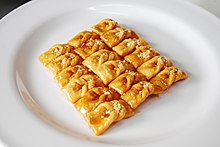Maejap-gwa
 | |
| Alternative names | Maejak-gwa, tarae-gwa |
|---|---|
| Type | Yumil-gwa |
| Place of origin | Korea |
| Associated cuisine | Korean cuisine |
| 150 kcal (628 kJ)[1] | |
| Korean name | |
| Hangul | 매잡과 |
|---|---|
| Hanja | 梅雜菓 |
| Revised Romanization | maejap-gwa |
| McCune–Reischauer | maejap-kwa |
| IPA | [mɛ.dʑap̚.k͈wa] |
| Hangul | 매작과 |
| Hanja | 梅雀菓 |
| Revised Romanization | maejak-gwa |
| McCune–Reischauer | maejak-kwa |
| IPA | [mɛ.dʑak̚.k͈wa] |
| Hangul | 타래과 |
| Hanja | 타래菓 |
| Revised Romanization | tarae-gwa |
| McCune–Reischauer | t'arae-gwa |
| IPA | [tʰa.ɾɛ.ɡwa] |
Maejap-gwa (Korean: 매잡과; Hanja: 梅雜菓), also called maejak-gwa (매작과; 梅雀菓) or tarae-gwa (타래과), is a ribbon-shaped hangwa (traditional Korean confection).[2][3][4]
Preparation
Wheat flour is kneaded with ginger juice and water, then rolled into a flat sheet.[5] The sheet is then cut into small rectangles with three slits in the middle, and the end of each piece is put through the middle slit.[5] The ribbons are then deep-fried, coated in honey or jocheong followed by chopped pine nuts.[5]
Gallery
-
Walnut jeonggwa (left) and maejap-gwa (right), from an Asiana airlines in-flight meal
See also
References
- ^ "Maejakgwa". Korean Food Foundation. Archived from the original on 22 April 2017. Retrieved 22 April 2017.
- ^ "maejap-gwa" 매잡과. Standard Korean Language Dictionary (in Korean). National Institute of Korean Language. Archived from the original on 23 April 2017. Retrieved 22 April 2017.
- ^ "maejak-gwa" 매작과. Standard Korean Language Dictionary (in Korean). National Institute of Korean Language. Archived from the original on 23 April 2017. Retrieved 22 April 2017.
- ^ "tarae-gwa" 타래과. Standard Korean Language Dictionary (in Korean). National Institute of Korean Language. Archived from the original on 23 April 2017. Retrieved 22 April 2017.
- ^ a b c Kwon, Yong-Seok; Kim, Young; Kim, Yang-Suk; Choe, Jeong-Sook; Lee, Jin-Young (2012). "An Exploratory Study on Kwa-Jung-ryu of Head Families". Journal of the Korean Society of Food Culture (in Korean). 27 (6): 588–597. doi:10.7318/kjfc/2012.27.6.588.


